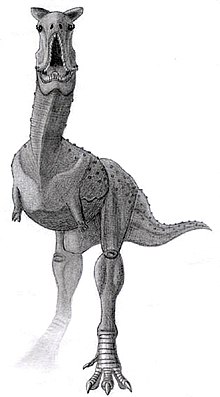Carnotaurus
| Carnotaurus Temporal range: Late Cretaceous
| |
|---|---|

| |
| Carnotaurus skeleton, Natural History Museum, London | |
| Scientific classification | |
| Kingdom: | |
| Phylum: | |
| Class: | |
| Superorder: | |
| Order: | |
| Suborder: | |
| Family: | |
| Subfamily: | |
| Tribe: | |
| Genus: | Carnotaurus Bonaparte, 1985
|
| Species | |
|
C. sastrei Bonaparte, 1985 (type) | |
Carnotaurus (Template:PronEng; meaning "meat-bull", referring to its distinct bull-like horns (Latin carne = flesh + Greek tauros = bull) was a large predatory dinosaur, with horns vaguely resembling a bull's. Only one species, Carnotaurus sastrei has been described so far.
Carnotaurus lived in Patagonia, Argentina during the Maastrichtian stage of the Late Cretaceous, and was discovered by José F. Bonaparte, who has uncovered many other South American dinosaurs.[1]
Description



Carnotaurus was a medium-sized theropod, about 9.0 m (30 ft) in length, 3 m tall at the hips, and weighing about 1,600 kg (1.76 tons). The most distinctive features of Carnotaurus are the two thick horns above the eyes, and the extremely reduced forelimbs with four fingers.[2] It is also characterized by its unusually long neck (compared to other theropods), and its small head with box-shaped jaws. It had a small skull, a thick chest, and a thin tail. The eyes of Carnotaurus faced forward, which is unusual in a dinosaur, and may indicate binocular vision and depth perception.
There is a rather puzzling contrast between Carnotaurus’ deep, robust-looking skull and its shallow, slender lower jaw. So far no-one has worked out what this might imply about its methods of feeding.[3]
A single nearly complete skeleton has been described including impressions of skin along almost the entire right side, that show Carnotaurus lacked feathers, unlike the more advanced coelurosaurian theropods (see also feathered dinosaurs). Instead, the skin is lined with rows of bumps, which become larger toward the spine.
The type species Carnotaurus sastrei is the only known species. Its closest relatives include Aucasaurus (Argentina), Majungasaurus (Madagascar), and Rajasaurus (India). Together, these dinosaurs form the subfamily Carnotaurinae in the family Abelisauridae. Among the carnotaurines, Carnotaurus is most closely related to Aucasaurus, and together these two genera form the tribe Carnotaurini.
In popular culture
Since the mid-1990s, Carnotaurus has been featured occasionally in the popular media. One of its earliest prominent roles in fiction was the 1995 sequel to Jurassic Park, Michael Crichton's The Lost World. In the novel, Carnotaurus was portrayed as having the (completely fictional) ability to change its colour to blend into the background, like a chameleon or a cuttlefish.[4] While it did not appear in the 1997 film adaptation of the novel, Carnotaurus subsequently appeared in numerous tie-ins to the Jurassic Park franchise, including several video games. Another prominent movie role for Carnotaurus came with the 2000 Walt Disney animated film Dinosaur, which featured two Carnotaurus attacking a large herd of herbivorous dinosaurs. The Carnotaurus in the film were much larger than the real life animal, scaled up to proportions more closely resembling the giant theropod Tyrannosaurus. In reality, Carnotaurus was even smaller than Iguanodon, the main dinosaur featured in the Disney picture.[5] This film later inspired a thrill ride at Disney's Animal Kingdom Park at Walt Disney World, which featured audio-animatronics of a Carnotaurus, in addition to a cast of other dinosaurs.
Sources
- Bonaparte (1991). "The Gondwanian theropod families Abelisauridae and Noasauridae." Historical Biology. An International Journal of Paleobiology, 5: 1-25.
- Lamanna, Martinez, and Smith (2002). "A definitive abelisaurid theropod dinosaur from the early Late Cretaceous of Patagonia." Journal of Vertebrate Paleontology, 22: 58–69.
References
- ^ Bonaparte (1985). "A horned Cretaceous carnosaur from Patagonia." National Geographic Research, 1: 149-151.
- ^ Bonaparte, Novas, and Coria (1990). "Carnotaurus sastrei Bonaparte, the horned, lightly built carnosaur from the Middle Cretaceous of Patagonia." Contributions in Science (Natural History Museum of Los Angeles County), 416: 41 pp.
- ^ Paul, G.S. (1988). Predatory Dinosaurs of the World. ISBN 0-671-61946-2.
- ^ Crichton, Michael (September 1995). The Lost World. Ballantine Books. p. 416 pp. doi:ISBN 0-679-41946-2.
{{cite book}}: Check|doi=value (help) - ^ Dinosaur (motion picture). USA. 2000-05-19.
{{cite AV media}}: Check date values in:|date=(help); Cite has empty unknown parameters:|producer=and|crew=(help); Unknown parameter|director=ignored (help); Unknown parameter|distributor=ignored (|publisher=suggested) (help)
External links
- The bite of Carnotaurus at Universidad Nacional de Mar del Plata. Template:Es icon
- Gerardo V. Mazzetta, Adrián P. Cisilino & R. Ernesto Blanco.Mandible stress distribution during the bite in Carnotaurus sastrei Bonaparte, 1985 (Theropoda: Abelisauridae). (2004) Ameghiniana 41: 605-617. Buenos Aires.
